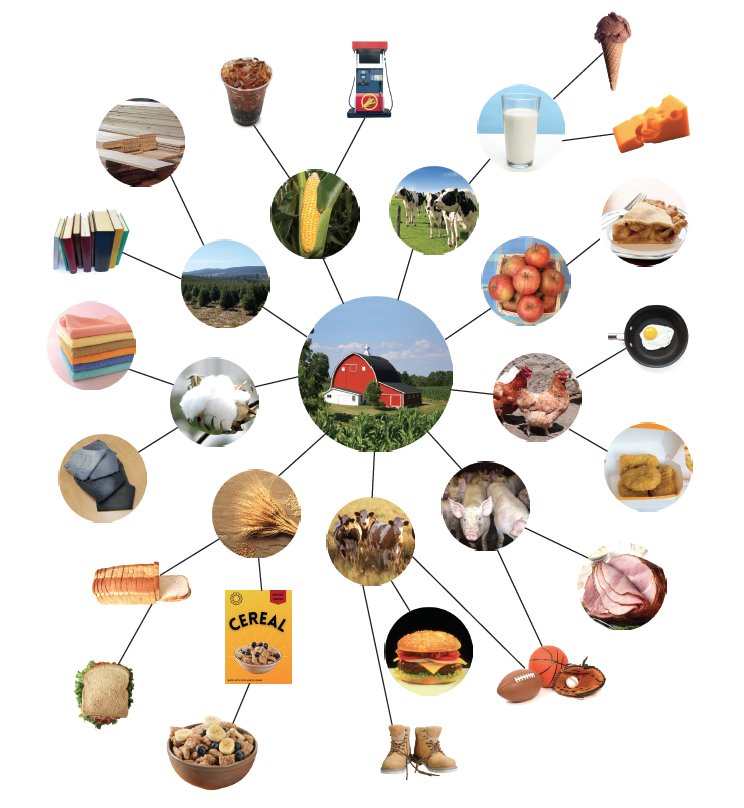My Farm Web (Grades K-2)
Students use the visual representation of a web to explore the role of agriculture in their daily lives and understand how most of the necessities of life can be traced back to the farm.
Background
Lesson Activities
Recommended Companion Resources
Credits
Author
Vanae Morris and Debra Spielmaker | Utah Agriculture in the Classroom
Sources
- https://www.northernag.net/how-much-popcorn-does-the-average-american-eat-each-year/
- https://msu.edu/~sindijul/Fruits%20and%20Vegetables/BANANAS.htm
- https://www.washingtonpost.com/news/to-your-health/wp/2015/01/20/we-eat-100-acres-of-pizza-a-day-in-the-u-s/?noredirect=on&utm_term=.7a6ae1e2d003
- https://columbustelegram.com/banner-press/news/fun-facts-about-the-food-we-eat/article_6cf8be89-0a8e-53f4-9a81-f9f2bfe1921b.html
Standards
Indiana Content Area Standards
-
English Language Arts.Kindergarten.SL.1
Listen actively and communicate effectively with a variety of audiences and for different purposes.
- Comprehension.K.SL.3.1: Ask and answer questions about key details in a text read aloud or information presented orally or through other media.
- Comprehension.K.SL.3.2: Ask appropriate questions about what a speaker says.
- Discussion and Collaboration.K.SL.2.1: Participate in collaborative conversations about grade-appropriate topics and texts with peers and adults in small and larger groups.
- Discussion and Collaboration.K.SL.2.3: Listen to others, take turns speaking, and add ones own ideas to small group discussions or tasks.
- Discussion and Collaboration.K.SL.2.4: Ask questions to seek help, get information, or clarify something that is not understood.
- Discussion and Collaboration.K.SL.2.5: Continue a conversation through multiple exchanges.
-
English Language Arts.Grade 1.SL.1
Listen actively and adjust the use of spoken language (e.g., vocabulary) to communicate effectively with a variety of audiences and for different purposes.
- Comprehension.1.SL.3.1: Ask and answer questions about what a speaker says to clarify something that is not understood.
- Comprehension.1.SL.3.2: Ask and answer questions about key details in a text read aloud or information presented orally or through other media.
- Discussion and Collaboration.1.SL.2.1: Participate in collaborative conversations about grade-appropriate topics and texts with peers and adults in small and larger groups.
- Discussion and Collaboration.1.SL.2.3: Listen to others, take turns speaking about the topic, and add ones own ideas in small group discussions or tasks.
- Discussion and Collaboration.1.SL.2.4: Ask questions to clarify information about topics and texts under discussion.
- Discussion and Collaboration.1.SL.2.5: Build on others talk in conversations by responding to the comments of others through multiple exchanges.
-
English Language Arts.Grade 2.SL.1
Listen actively and adjust the use of spoken language (e.g., conventions, vocabulary) to communicate effectively with a variety of audiences and for different purposes.
- Comprehension.2.SL.3.2: Ask and answer questions about what a speaker says to clarify comprehension, gather information, or deepen understanding of a topic or issue.
- Discussion and Collaboration.2.SL.2.1: Participate in collaborative conversations about grade-appropriate topics and texts with peers and adults in small and larger groups.
- Discussion and Collaboration.2.SL.2.3: Listen to others, take ones turn in respectful ways, and speak one at a time about the topics and text under discussion.
- Discussion and Collaboration.2.SL.2.4: Ask for clarification and further explanation as needed about the topics and texts under discussion.
- Discussion and Collaboration.2.SL.2.5: Build on others talk in conversations by linking comments to the remarks of others.
